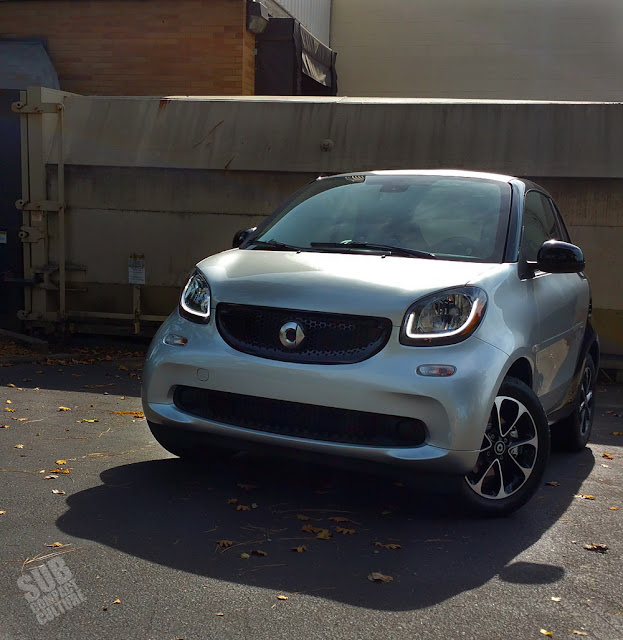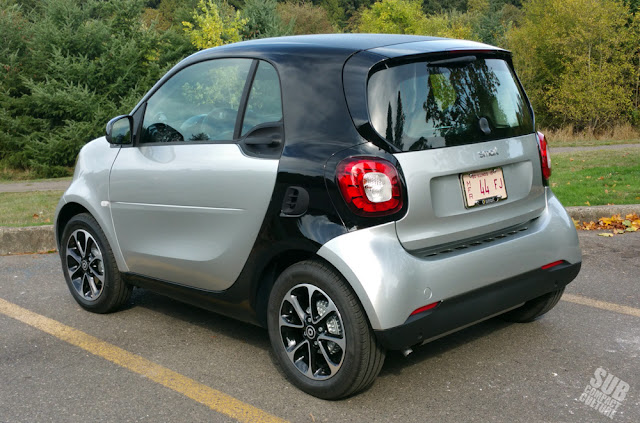Words by Andy Lilienthal, photos by Mercedes Lilienthal
I’ll admit: I’m a bit surprised Smart is still around in the U.S. In a country where space isn’t at a premium in most places and people drive enormous pickup trucks to run errands in urban environments, peddling a microcar to Americans can seem like a bit of a stretch. However, Smart has been selling cars in the U.S. since 2008, and doesn’t appear to be stopping any time soon.
When Scion released its iQ, I figured it was going to wipe out the Smart brand entirely. The iQ drove better and felt more solid, had Toyota's reputation for quality and reliability, and didn't require premium fuel. It seemed like a shoe-in to take over as King of the Microcars. Alas, Scion dropped the iQ for 2015, while Smart has unveiled an all-new version of the Fortwo. Hey, I’ve been wrong before.
Now the only true two-seat micro car for sale on the U.S. market, the 2016 Smart Fortwo has been totally redesigned, and features more comfort, better driving dynamics, turbo power, and—thankfully—a new transmission (two of them, actually).
Yes, the ’16 Fortwo is still small. Damn small at that. The car’s total length is 0.2-inches shorter than the wheelbase on the current Toyota Corolla. While the length remains the same as the previous Fortwo, the ’16 is wider by about four inches, which helps with all kinds of things including stability and interior volume. You’re no longer elbow to elbow with your passengers. The entire exterior has been restyled, although no one will mistake the vehicle for anything other than a Smart. I found the new exterior to be attractive and well styled; it looks a little more grown up compared to the last model that looked like a Japanese ChoroQ toy. I mean, it’s still cute, but not too cute, and the redesign brings a fresh look to the iconic minicar.
Buyers still have the option to get both the plastic body panels and Tridion safety cell in a variety of colors. Our silver and black model had a minimal, understated look. I really like the LED accent/parking lights up front. I cannot say, however, that I was a fan of the wheels. Then again, I’m not a fan of most wheels that are partially painted black. For what it’s worth, those are 15x5-inch wheels and 165/65/15 tires up front, and 15x5.5-inch wheels and 185/60/15 tires out back. I'm also not a fan of the silver-painted drum brakes, which tend to look like Lego pieces. If this were my car, I'd hit them with some high-temp black paint. Afterall, no one wants to show off their sweet rear drums.
Inside, the new Fortwo is not even in the same category as the previous model. You know that kid in high school whose voice was high and he weighed 90 lbs as a sophomore, an then as a junior his voice was an octive lower, he’d filled out, and suddenly wasn’t as much of a nerd? Yeah, that’s this car. Compared to the previous models, this one looks modern and feels rock solid, too. There is a unique design aesthetic that works here that may even have some touches from Mercedes-Benz (look at pics of the CLA’s interior). The interior isn’t nearly as bare bones as the last model. The seats are wider and more plush, the interior materials feel well made and substantial. Few things feel cheap. There’s the simple analog speedometer in front of you with a multi-function color LCD trip computer. A pod-like tachometer with clock resides atop the upper left corner of the dash, and the infotainment system, which springs from the dashboard, is easy to use. The climate control is simple yet funky. It's got a retro slider to control the temperature, and red or yellow bars illuminate around the buttons which get pressed; very cool. There is a lot of piano black finish, which does tend to scratch easily and gets a lot of fingerprints, but Mercedes thinks the simple radio readout looks like something from the 1980s, in contrast to the multicolor LCD on the trip computer. The fabric-covered dash does feel like you could snag something on it and rip it. The stereo sounds adequate, although nothing earth shattering (there is an available JBL unit, however).
The interior isn’t perfect, and there are going to be compromises in a car this Lilliputian. Firstly, there isn’t much storage space for anything. I mean, I didn’t expect to get a mammoth suitcase in the car, but there’s no good place to put things like your mobile phone. Smart will gladly sell you a mobile phone cradle for about $100. Also, the cup holders are itsy-bitsy. There are three of them (two on the dash, one in the center console), but none would fit my Hydroflask coffee mug. Thankfully, it would fit in the door, although it always felt like it was about to fly out.
The area behind the seats can easily accommodate a couple of backpacks, a small suitcase, or a few bags of groceries, and I like the clamshell tailgate, which also opens up for more storage. Our model also had a roll-up tonneau cover to protect cargo from prying eyes. It also had a cargo net directly behind the seats, which is a good way to stow jackets, gloves, etc. I was able to fit a beer growler there, for what it’s worth. Going solo and need to get something bigger in the Fortwo? The passenger’s seat folds flat.
The seating position is very upright, but that’s to be expected in a car that’s shaped a bit like a phone booth. But alas—no tilt or telescoping steering wheel. The driver’s seat does have height adjustability, however—a $100 option.
As mentioned, the previous generation Fortwo had one of my least favorite transmissions of all time. Thankfully, Smart has sent that one to hell where it belongs in favor of either a six-speed dual-clutch automatic with manual shifting capability, or a true five-speed manual (yay!). Our tester was the automatic, but it worked exceptionally well with the tiny 898cc turbocharged engine. Yes, I said turbocharged. That’s right boy racers, this is a turbocharged, rear-wheel drive car. Not even your Scion FR-S can say that. OK, OK, so it’s not exactly a sports car, but the force-fed three-pot works great in this 2,000 lb. runabout. Acceleration feels brisk, with published 0-60 times around 10 seconds. Merging with traffic is no longer a life-threatening activity. In fact, 0-40 feels downright speedy. The engine, mounted between the rear wheels, produces 89 horsepower and a healthy 100 ft/lbs of torque. Shifts feel smooth and quick, and the manual mode works well. There is a bit of funkiness at idle, as the car vibrates until the clutch disengages, or at least I assume that’s what’s going on. Also, the car sounds rather noisy when it first starts up. Not sure what's up with that.
To access the engine, you need to remove the rear carpet panel and unscrew several fasteners. While I didn't take the engine cover all the way off, I'd assume it's not exactly easy to simply "pop the hood" to check your oil levels. And if you're wondering what's actually under the hood (e.g. the front), simply pull two levers mounted in the grille, and the front panel can be detached, although it's held on by two nylon straps. Once off, you'll find a battery and coolant and windshield wiper fluid reservoirs.
Once underway, the car rides better than I would’ve expected, with a firm but well damped feel—it’s actually kind of European feeling. Yes, you will get a bit of porpoising or bucking when you go over some of the bumps, but that’s a side effect of any car with a wheelbase as short as this. I had the car up to speeds as high as 75 MPH, and it felt wonderfully solid and secure, not nervous like I remember Scion iQ feeling. I was also not expecting the car to be as quiet as it was at most times. Even when pushed, the engine never sounded overtly loud. There is a significant amount of wind noise at highway speeds, though. And yes, it’s got cruise control, so you can easily take longer trips in the car without feeling like you’re going to want to scratch your eyes out with sporks (two of them).
Handling is also better than I would’ve expected. Hard cornering would occasionally engage the traction control, but spirited driving was actually kind of fun, although it requires your full attention. Remember, if this thing starts to rotate, you’re essentially sitting on the rear wheels, so it’ll come around quickly. But wait, the Smart’s best trick is its insane turning circle of only 22.8 ft. For comparison’s sake, the tiny Fiat 500 has a turning circle of 30.6 ft.; the MINI Cooper? 35.1 ft. The car essentially turns around in its own freaking space. It is absolutely amazing and completely genius for parking. You can whip a U-turn faster than can say U-turn.
I know, I know. The Fortwo still doesn’t crack the 40 MPG barrier. I can hear it now. “A car that small should get like 700 MPG!” Alas, the teeny cars generally don’t get as good fuel economy as larger ones that allow for larger engines that don’t have to work as hard. For what it’s worth, we still got 38 MPG on mixed driving, and yes, it still drinks premium fuel. Thankfully, the tank is only 7.66 gallons.
The idea of safety always comes up with these smallest of small cars. I can tell you this car has eight airbags, the Tridion safety cell, ABS, ESP, and traction control. It also has crosswind mitigation. The 2016's crash test rating hasn't been released yet, but I can tell you that the previous version had the IIHS (Insurance Institute of Highway Safety) "Good" rating (their highest) across the board with the exception of an "Average" rating for head restraints and seats. And while you can't fool physics, this is about as safe as you can get in a car this small.
You know, this new Smart is so much better than the outgoing one, it’s crazy. Kudos to Daimler for doing such a good job with this car. It’s fun to drive, has gobs of personality, and is great for commuting. Honestly, I’m smitten with the new Smart Fortwo, and could see owning one (with the manual transmission). Our tester was the Passion model and it retails for $16,890 and change; ours had $1,440 worth of options including silver paint, the automatic, and the height-adjustable seats. If you just want the basic model, a Fortwo Pure starts at $14,650. No, it’s not the cheapest car on the market, but its combination of personality, agility, and fun fits the bill for many urban dwellers. And now that the car is vastly improved over the last version, it might actually appeal to a larger audience—me included.
| THE BASICS: 2016 Smart Fortwo Passion | |
|---|---|
| MSRP As Tested: | $18,330 |
| Engine: | Turbocharged 898cc three cylinder |
| Transmission: | 6-speed dual-clutch automatic |
| Horsepower: | 89 |
| Torque: | 100 lbs/ft |
| Curb Weight: | 2,053 lbs. |
| Wheelbase: | 73.7" |
| Overall Length: | 106.1" |
| Suspension: | F: MacPherson Strut Front Suspension R: De Dion |
| Brakes: | F: Disc w/ABS R: Drum w/ABS |
| Wheels: | 15x5 F, 15x5.5 rear; alloy |
| Tires: | 165/65/15 F, 185/60/15 R |
| Fuel Economy (MPG): | 32 city, 39 highway, 35 combined |













No comments:
Post a Comment